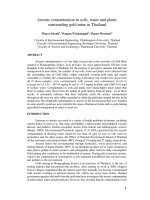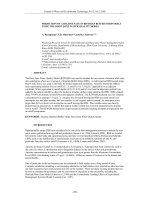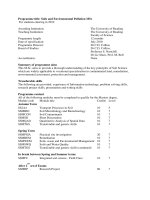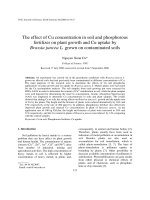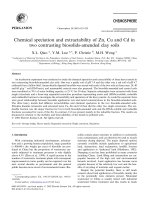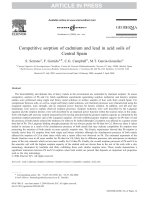Soils minerals
Bạn đang xem bản rút gọn của tài liệu. Xem và tải ngay bản đầy đủ của tài liệu tại đây (5.39 MB, 61 trang )
BIOL 100C:
Introductory Biology III
Soils & Minerals; Water Transport
Dr. P. Narguizian
Fall 2012
Principles of Biology
Planting Hope in the Wake of Katrina
Many plants can remove toxins such as
heavy metals from soils by taking them up
with their roots and storing them in their
bodies
The use of plants to clean up polluted soil
and groundwater is called phytoremediation
Copyright © 2009 Pearson Education, Inc.
Planting Hope in the Wake of Katrina
Concerns associated with phytoremediation
include
– Release of toxins into the air via evaporation from
plant leaves
– Disposal of plants with high concentrations of
pollutants
– Possible toxicity to animals that eat plants with
high concentrations of pollutants
Copyright © 2009 Pearson Education, Inc.
THE UPTAKE AND
TRANSPORT
OF PLANT NUTRIENTS
Copyright © 2009 Pearson Education, Inc.
Plants acquire their nutrients from soil and air
Plants take up carbon dioxide from the air to
produce sugars via photosynthesis; oxygen is
produced as a product of photosynthesis
Plants obtain water, minerals, and some
oxygen from the soil
Using simple sugars as an energy source and
as building blocks, plants convert the
inorganic molecules they take up into the
organic molecules of living plant tissue
Copyright © 2009 Pearson Education, Inc.
32.1 Plants acquire their nutrients from soil and
air
Inorganic molecules taken up by plants
– Carbon dioxide
– Nitrogen
– Magnesium
– Phosphorus
Copyright © 2009 Pearson Education, Inc.
Plants acquire their nutrients from soil and air
Organic molecules produced by plants
– Carbohydrates
– Lipids
– Proteins
– Nucleic acids
Copyright © 2009 Pearson Education, Inc.
CO2
Minerals
H2O
O2
The plasma membranes of root cells control solute
uptake
Minerals taken up by plant roots are in a
watery solution
Water and minerals are absorbed through the
epidermis of the root and must be taken up by
root cells before they enter the xylem
Selective permeability of the plasma
membrane of root cells controls what
minerals enter the xylem
Copyright © 2009 Pearson Education, Inc.
The plasma membranes of root cells control solute
uptake
There are two pathways by which water
and minerals enter the xylem
– Intracellular route—water and solutes
are selectively taken up by a root
epidermal cell, usually a root hair, and
transported from cell to cell through
plasmodesmata
– Extracellular route—water and solutes
pass into the root in the porous cell walls
of root cells; they do not enter any cell
plasma membrane until they reach the
root endodermis
Copyright © 2009 Pearson Education, Inc.
The plasma membranes of root cells control solute
uptake
The cells of the endodermis contain a waxy
barrier called the Casparian strip
– Water and solutes that have entered the root
without crossing a cell plasma membrane are
blocked
– Specialized cells of the endodermis take up
water and minerals selectively
– The Casparian strip regulates uptake of minerals
that enter the root via the extracellular route
Copyright © 2009 Pearson Education, Inc.
Root hair
Epidermis
Cortex
Phloem
Key
Dermal tissue system
Ground tissue system
Vascular tissue system
Xylem
Casparian
strip
Endodermis
Extracellular route,
via cell walls;
stopped by
Casparian strip
Casparian strip
Xylem
Root hair
Plasmodesmata
Intracellular
route, via
cell interiors,
through
plasmodesmata
Epidermis
Endodermis
Cortex
Root hair
Epidermis
Cortex
Phloem
Key
Dermal tissue system
Ground tissue system
Vascular tissue system
Xylem
Casparian
strip
Endodermis
Extracellular route,
via cell walls;
stopped by
Casparian strip
Casparian strip
Xylem
Root hair
Plasmodesmata
Intracellular
route, via
cell interiors,
through
plasmodesmata
Epidermis
Endodermis
Cortex
Transpiration pulls water up xylem vessels
Xylem sap is the solution carried up through a
plant in tracheids and vessel elements
Xylem sap is pulled up through roots and
shoots to the leaves
Evaporation of water from the surface of
leaves, called transpiration, is the driving
force for the movement of xylem sap
Water’s cohesion and adhesion allow water to
be pulled up to the top of the highest trees
Copyright © 2009 Pearson Education, Inc.
Transpiration pulls water up xylem vessels
Transpiration-cohesion-tension mechanism
– Water’s cohesion describes its ability to stick to itself
– Water’s adhesion describes its ability to stick to other
surfaces; water adheres to the inner surface of xylem
cells
– A steep diffusion gradient pulls water molecules from
the surface of leaves into much drier air
– The air’s pull on water creates a tension that pulls on
water in the xylem; since water is cohesive, it is pulled
along, much as when a person sucks on a straw
Copyright © 2009 Pearson Education, Inc.
Flow of water
H2O
Transpiration
(regulated by guard cells
surrounding stomata)
Cohesion and adhesion in xylem
(cohesion of H2O molecules to
each other and adhesion of H2O
molecules to cell walls)
H2O
Water uptake
(via root hairs)
Xylem sap
Mesophyll cells
Air space within leaf
Stoma
1
Flow of water
Transpiration
Outside air
Xylem sap
Mesophyll cells
Air space within leaf
Stoma
1
Outside air
Flow of water
Transpiration
Water
molecule
2
Cohesion
in the xylem
Xylem
cells
Cohesion
by hydrogen
bonding
Xylem sap
Mesophyll cells
Air space within leaf
Stoma
1
Outside air
Flow of water
Transpiration
Water
molecule
2
Cohesion
in the xylem
Xylem
cells
3
Root hair
Soil particle
Water
Water uptake from soil
Cohesion
by hydrogen
bonding
Xylem sap
Mesophyll cells
Air space within leaf
Stoma
1
Outside air
Adhesion
Transpiration
Flow of water
4
Cell
wall
Water
molecule
2
Cohesion and
adhesion in the xylem
Xylem
cells
3
Root hair
Soil particle
Water
Water uptake from soil
Cohesion
by hydrogen
bonding
Guard cells control transpiration
Plants must open pores in leaves called
stomata to allow CO2 to enter for
photosynthesis
Water evaporates from the surface of leaves
through stomata
Paired guard cells surround each stoma
Guard cells can regulate the amount of water
lost from leaves by changing shape and
closing the stomatal pore
Copyright © 2009 Pearson Education, Inc.
Guard cells control transpiration
Stomata open when guard cells take up water
– Potassium is actively taken up by guard cells from
nearby cells
– This creates an osmotic gradient and water follows
– Uneven cell walls of guard cells causes them to bow
when water is taken up
– The bowing of the guard cells causes the pore of the
stoma to open
When guard cells lose K+ ions, the guard cells
become flaccid and the stoma closes
Copyright © 2009 Pearson Education, Inc.
Stoma
H2O
Guard cells
H2O
H2O
H2O
H2O
H2O
K+
Vacuole
H2O
H2O
H2O
H2O
Stoma opening
Stoma closing
